STRATEGIC MANAGEMENT Strategic Management Author's Note: Strategic Management on the basis of 5 whys methodology
VerifiedAdded on 2023/04/23
|17
|4389
|475
AI Summary
Contribute Materials
Your contribution can guide someone’s learning journey. Share your
documents today.

Running head: STRATEGIC MANAGEMENT
Strategic Management
Name of the Student:
Name of the University:
Author’s Note:
Strategic Management
Name of the Student:
Name of the University:
Author’s Note:
Secure Best Marks with AI Grader
Need help grading? Try our AI Grader for instant feedback on your assignments.
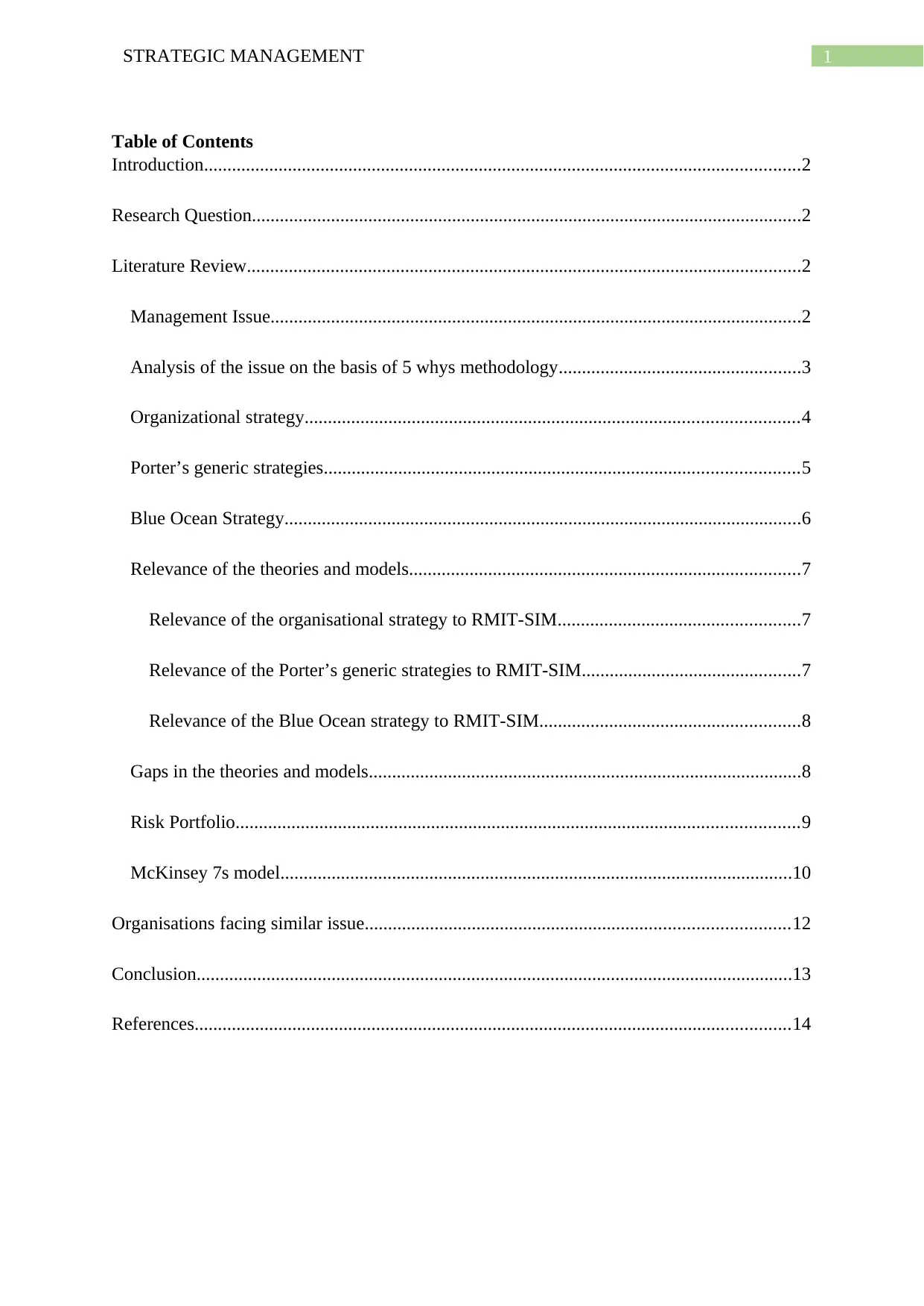
1STRATEGIC MANAGEMENT
Table of Contents
Introduction................................................................................................................................2
Research Question......................................................................................................................2
Literature Review.......................................................................................................................2
Management Issue..................................................................................................................2
Analysis of the issue on the basis of 5 whys methodology....................................................3
Organizational strategy..........................................................................................................4
Porter’s generic strategies......................................................................................................5
Blue Ocean Strategy...............................................................................................................6
Relevance of the theories and models....................................................................................7
Relevance of the organisational strategy to RMIT-SIM....................................................7
Relevance of the Porter’s generic strategies to RMIT-SIM...............................................7
Relevance of the Blue Ocean strategy to RMIT-SIM........................................................8
Gaps in the theories and models.............................................................................................8
Risk Portfolio.........................................................................................................................9
McKinsey 7s model..............................................................................................................10
Organisations facing similar issue...........................................................................................12
Conclusion................................................................................................................................13
References................................................................................................................................14
Table of Contents
Introduction................................................................................................................................2
Research Question......................................................................................................................2
Literature Review.......................................................................................................................2
Management Issue..................................................................................................................2
Analysis of the issue on the basis of 5 whys methodology....................................................3
Organizational strategy..........................................................................................................4
Porter’s generic strategies......................................................................................................5
Blue Ocean Strategy...............................................................................................................6
Relevance of the theories and models....................................................................................7
Relevance of the organisational strategy to RMIT-SIM....................................................7
Relevance of the Porter’s generic strategies to RMIT-SIM...............................................7
Relevance of the Blue Ocean strategy to RMIT-SIM........................................................8
Gaps in the theories and models.............................................................................................8
Risk Portfolio.........................................................................................................................9
McKinsey 7s model..............................................................................................................10
Organisations facing similar issue...........................................................................................12
Conclusion................................................................................................................................13
References................................................................................................................................14
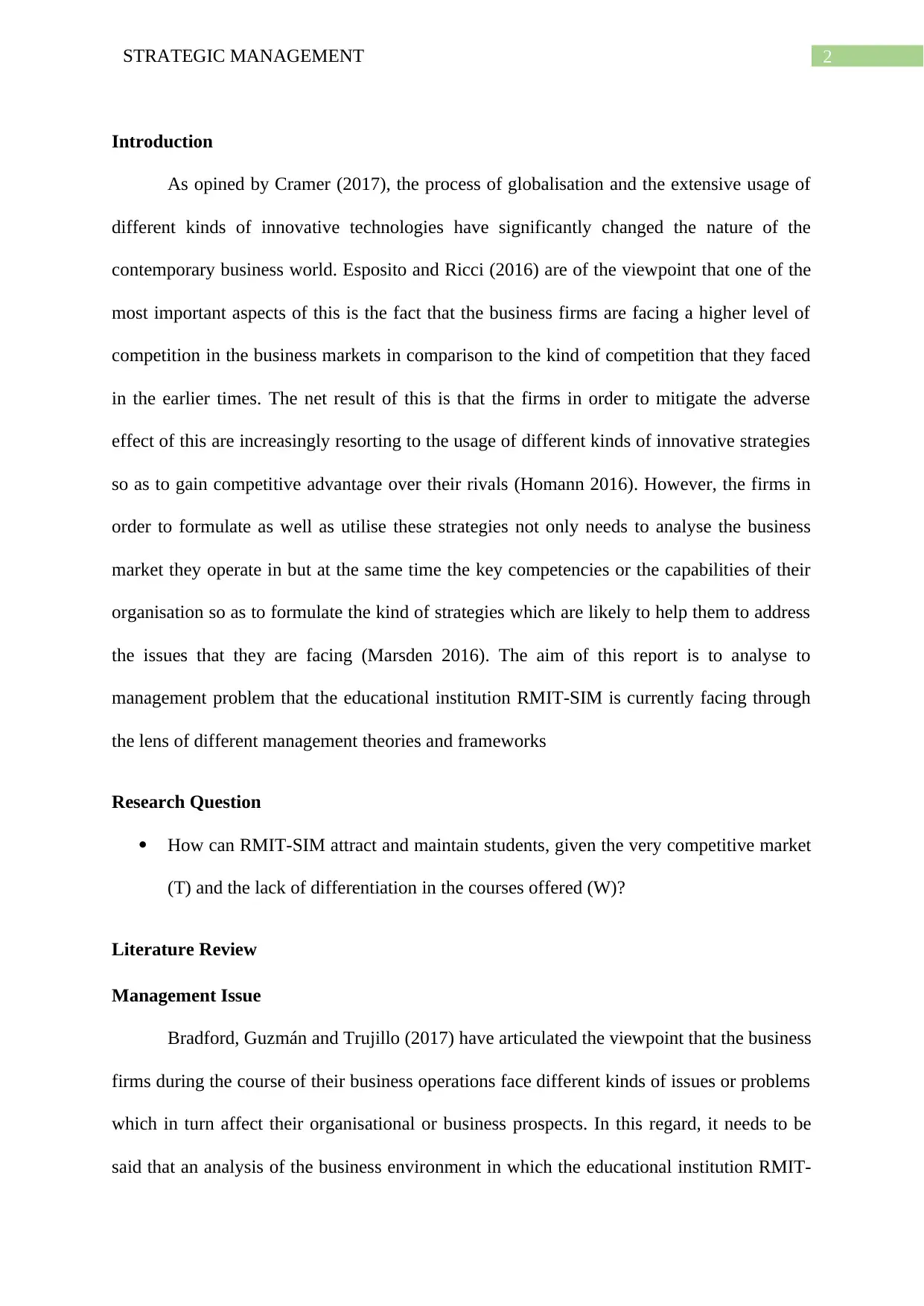
2STRATEGIC MANAGEMENT
Introduction
As opined by Cramer (2017), the process of globalisation and the extensive usage of
different kinds of innovative technologies have significantly changed the nature of the
contemporary business world. Esposito and Ricci (2016) are of the viewpoint that one of the
most important aspects of this is the fact that the business firms are facing a higher level of
competition in the business markets in comparison to the kind of competition that they faced
in the earlier times. The net result of this is that the firms in order to mitigate the adverse
effect of this are increasingly resorting to the usage of different kinds of innovative strategies
so as to gain competitive advantage over their rivals (Homann 2016). However, the firms in
order to formulate as well as utilise these strategies not only needs to analyse the business
market they operate in but at the same time the key competencies or the capabilities of their
organisation so as to formulate the kind of strategies which are likely to help them to address
the issues that they are facing (Marsden 2016). The aim of this report is to analyse to
management problem that the educational institution RMIT-SIM is currently facing through
the lens of different management theories and frameworks
Research Question
How can RMIT-SIM attract and maintain students, given the very competitive market
(T) and the lack of differentiation in the courses offered (W)?
Literature Review
Management Issue
Bradford, Guzmán and Trujillo (2017) have articulated the viewpoint that the business
firms during the course of their business operations face different kinds of issues or problems
which in turn affect their organisational or business prospects. In this regard, it needs to be
said that an analysis of the business environment in which the educational institution RMIT-
Introduction
As opined by Cramer (2017), the process of globalisation and the extensive usage of
different kinds of innovative technologies have significantly changed the nature of the
contemporary business world. Esposito and Ricci (2016) are of the viewpoint that one of the
most important aspects of this is the fact that the business firms are facing a higher level of
competition in the business markets in comparison to the kind of competition that they faced
in the earlier times. The net result of this is that the firms in order to mitigate the adverse
effect of this are increasingly resorting to the usage of different kinds of innovative strategies
so as to gain competitive advantage over their rivals (Homann 2016). However, the firms in
order to formulate as well as utilise these strategies not only needs to analyse the business
market they operate in but at the same time the key competencies or the capabilities of their
organisation so as to formulate the kind of strategies which are likely to help them to address
the issues that they are facing (Marsden 2016). The aim of this report is to analyse to
management problem that the educational institution RMIT-SIM is currently facing through
the lens of different management theories and frameworks
Research Question
How can RMIT-SIM attract and maintain students, given the very competitive market
(T) and the lack of differentiation in the courses offered (W)?
Literature Review
Management Issue
Bradford, Guzmán and Trujillo (2017) have articulated the viewpoint that the business
firms during the course of their business operations face different kinds of issues or problems
which in turn affect their organisational or business prospects. In this regard, it needs to be
said that an analysis of the business environment in which the educational institution RMIT-
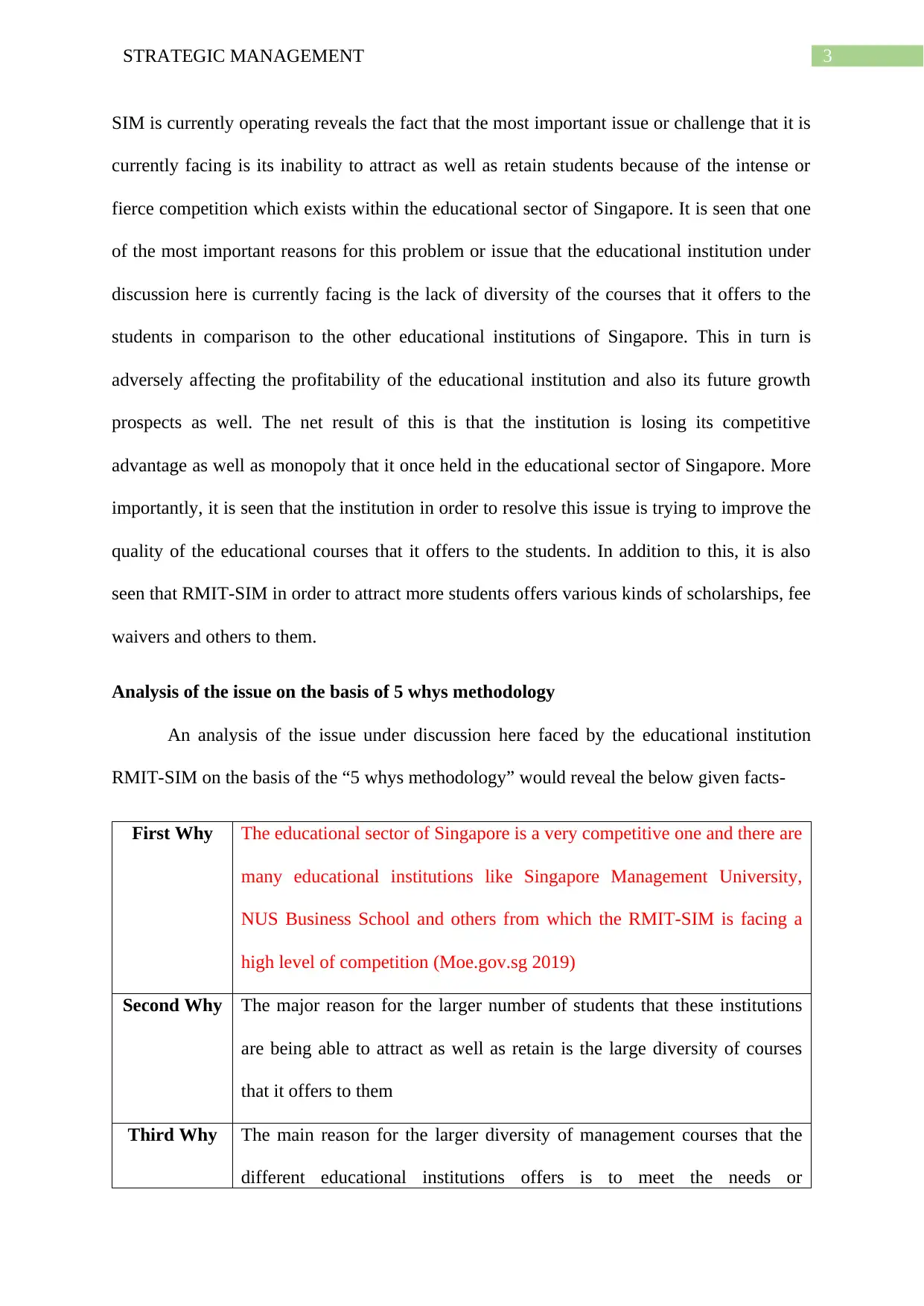
3STRATEGIC MANAGEMENT
SIM is currently operating reveals the fact that the most important issue or challenge that it is
currently facing is its inability to attract as well as retain students because of the intense or
fierce competition which exists within the educational sector of Singapore. It is seen that one
of the most important reasons for this problem or issue that the educational institution under
discussion here is currently facing is the lack of diversity of the courses that it offers to the
students in comparison to the other educational institutions of Singapore. This in turn is
adversely affecting the profitability of the educational institution and also its future growth
prospects as well. The net result of this is that the institution is losing its competitive
advantage as well as monopoly that it once held in the educational sector of Singapore. More
importantly, it is seen that the institution in order to resolve this issue is trying to improve the
quality of the educational courses that it offers to the students. In addition to this, it is also
seen that RMIT-SIM in order to attract more students offers various kinds of scholarships, fee
waivers and others to them.
Analysis of the issue on the basis of 5 whys methodology
An analysis of the issue under discussion here faced by the educational institution
RMIT-SIM on the basis of the “5 whys methodology” would reveal the below given facts-
First Why The educational sector of Singapore is a very competitive one and there are
many educational institutions like Singapore Management University,
NUS Business School and others from which the RMIT-SIM is facing a
high level of competition (Moe.gov.sg 2019)
Second Why The major reason for the larger number of students that these institutions
are being able to attract as well as retain is the large diversity of courses
that it offers to them
Third Why The main reason for the larger diversity of management courses that the
different educational institutions offers is to meet the needs or
SIM is currently operating reveals the fact that the most important issue or challenge that it is
currently facing is its inability to attract as well as retain students because of the intense or
fierce competition which exists within the educational sector of Singapore. It is seen that one
of the most important reasons for this problem or issue that the educational institution under
discussion here is currently facing is the lack of diversity of the courses that it offers to the
students in comparison to the other educational institutions of Singapore. This in turn is
adversely affecting the profitability of the educational institution and also its future growth
prospects as well. The net result of this is that the institution is losing its competitive
advantage as well as monopoly that it once held in the educational sector of Singapore. More
importantly, it is seen that the institution in order to resolve this issue is trying to improve the
quality of the educational courses that it offers to the students. In addition to this, it is also
seen that RMIT-SIM in order to attract more students offers various kinds of scholarships, fee
waivers and others to them.
Analysis of the issue on the basis of 5 whys methodology
An analysis of the issue under discussion here faced by the educational institution
RMIT-SIM on the basis of the “5 whys methodology” would reveal the below given facts-
First Why The educational sector of Singapore is a very competitive one and there are
many educational institutions like Singapore Management University,
NUS Business School and others from which the RMIT-SIM is facing a
high level of competition (Moe.gov.sg 2019)
Second Why The major reason for the larger number of students that these institutions
are being able to attract as well as retain is the large diversity of courses
that it offers to them
Third Why The main reason for the larger diversity of management courses that the
different educational institutions offers is to meet the needs or
Secure Best Marks with AI Grader
Need help grading? Try our AI Grader for instant feedback on your assignments.
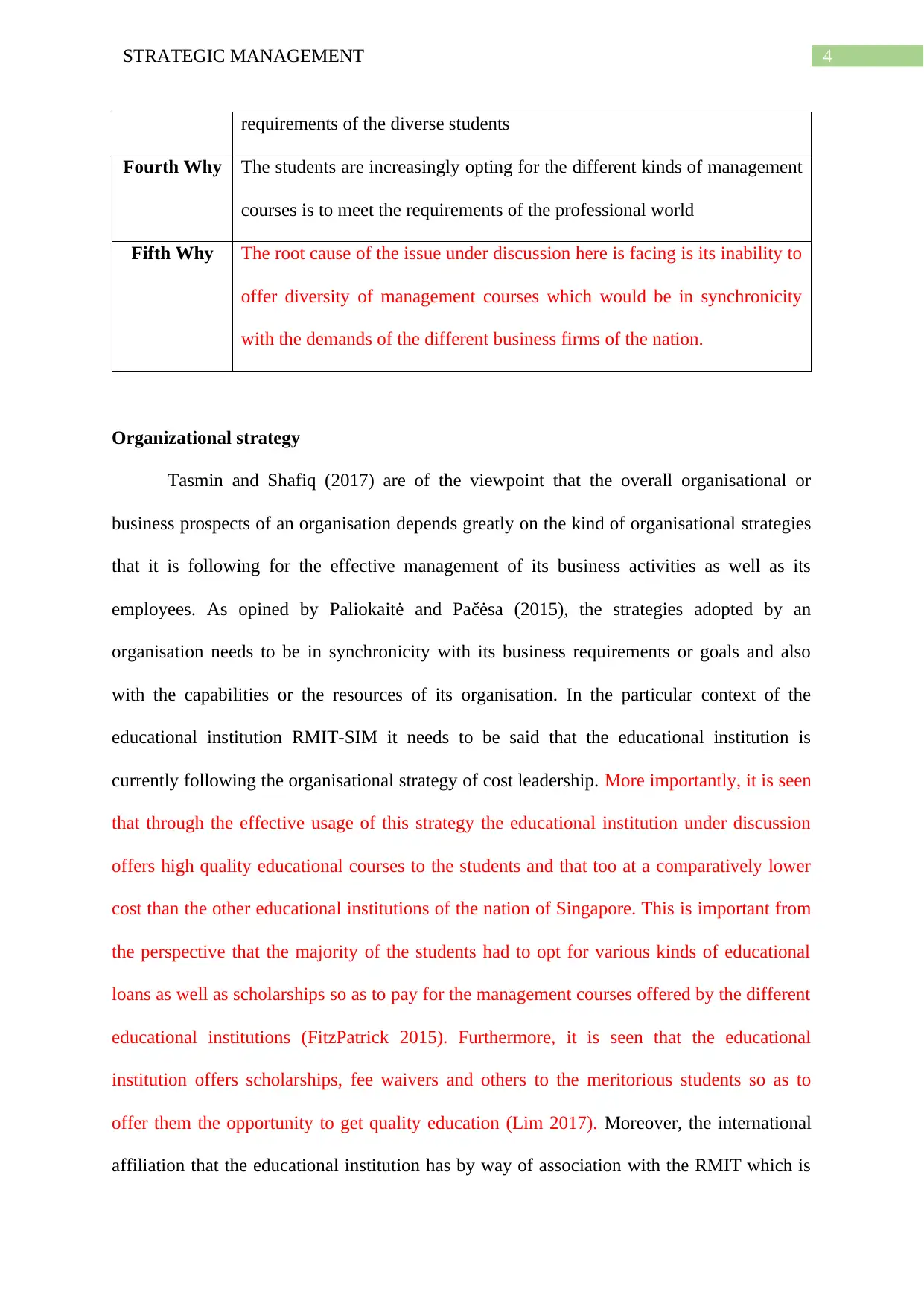
4STRATEGIC MANAGEMENT
requirements of the diverse students
Fourth Why The students are increasingly opting for the different kinds of management
courses is to meet the requirements of the professional world
Fifth Why The root cause of the issue under discussion here is facing is its inability to
offer diversity of management courses which would be in synchronicity
with the demands of the different business firms of the nation.
Organizational strategy
Tasmin and Shafiq (2017) are of the viewpoint that the overall organisational or
business prospects of an organisation depends greatly on the kind of organisational strategies
that it is following for the effective management of its business activities as well as its
employees. As opined by Paliokaitė and Pačėsa (2015), the strategies adopted by an
organisation needs to be in synchronicity with its business requirements or goals and also
with the capabilities or the resources of its organisation. In the particular context of the
educational institution RMIT-SIM it needs to be said that the educational institution is
currently following the organisational strategy of cost leadership. More importantly, it is seen
that through the effective usage of this strategy the educational institution under discussion
offers high quality educational courses to the students and that too at a comparatively lower
cost than the other educational institutions of the nation of Singapore. This is important from
the perspective that the majority of the students had to opt for various kinds of educational
loans as well as scholarships so as to pay for the management courses offered by the different
educational institutions (FitzPatrick 2015). Furthermore, it is seen that the educational
institution offers scholarships, fee waivers and others to the meritorious students so as to
offer them the opportunity to get quality education (Lim 2017). Moreover, the international
affiliation that the educational institution has by way of association with the RMIT which is
requirements of the diverse students
Fourth Why The students are increasingly opting for the different kinds of management
courses is to meet the requirements of the professional world
Fifth Why The root cause of the issue under discussion here is facing is its inability to
offer diversity of management courses which would be in synchronicity
with the demands of the different business firms of the nation.
Organizational strategy
Tasmin and Shafiq (2017) are of the viewpoint that the overall organisational or
business prospects of an organisation depends greatly on the kind of organisational strategies
that it is following for the effective management of its business activities as well as its
employees. As opined by Paliokaitė and Pačėsa (2015), the strategies adopted by an
organisation needs to be in synchronicity with its business requirements or goals and also
with the capabilities or the resources of its organisation. In the particular context of the
educational institution RMIT-SIM it needs to be said that the educational institution is
currently following the organisational strategy of cost leadership. More importantly, it is seen
that through the effective usage of this strategy the educational institution under discussion
offers high quality educational courses to the students and that too at a comparatively lower
cost than the other educational institutions of the nation of Singapore. This is important from
the perspective that the majority of the students had to opt for various kinds of educational
loans as well as scholarships so as to pay for the management courses offered by the different
educational institutions (FitzPatrick 2015). Furthermore, it is seen that the educational
institution offers scholarships, fee waivers and others to the meritorious students so as to
offer them the opportunity to get quality education (Lim 2017). Moreover, the international
affiliation that the educational institution has by way of association with the RMIT which is

5STRATEGIC MANAGEMENT
originally based in Australia is another gratification factor along with the low fees charged by
the institution which motivates the students to pursue the courses offered by the institution.
Thus, the RMIT-SIM would have to design its organisational strategy in such a manner that
would support the aggressive pricing strategy followed by it and also enable it to offer
different kinds of management courses which will be in synchronicity with the demands or
the needs of the diverse business firms of Singapore as well. This is likely to enable the
educational institution to attract as well as retain a large number of students.
Porter’s generic strategies
Berry, Broadbent and Otley (2016) are of the viewpoint that the Porter’s generic
strategies are a conglomeration of strategies which indicates the manner in which a particular
firm conducts its business in the business market so as to gain competitive advantage. As
opined by Guo and Huang (2016), there are four generic strategic options available to the
firms, namely, cost leadership, cost focus, product differentiation and differentiation focus.
As already mentioned, the educational institution RMIT-SIM follows the strategy of cost
leadership to attract as well as retain students and thereby to attain competitive advantage
within the educational sector of Singapore. However, in the recent times it is seen that a
larger number of educational institutions offers better quality management course have
emerged in the educational sector of Singapore (Crosling, Nair and Vaithilingam 2015). More
importantly, it is seen that taking the help of the strategy of product differentiation that these
institutions are offer a plethora of management courses which are in synchronicity with the
requirements of the diverse contemporary business firms (Barkema et al. 2015). It is pertinent
to note that this extensive focus of the educational institutions on the requirements or the
demands of the professional business world is the one which had enabled these institutions to
attain competitive advantage within the educational sector of Singapore. Thus, it can be said
that the educational institution RMIT-SIM in order to attract as well as retain a larger number
originally based in Australia is another gratification factor along with the low fees charged by
the institution which motivates the students to pursue the courses offered by the institution.
Thus, the RMIT-SIM would have to design its organisational strategy in such a manner that
would support the aggressive pricing strategy followed by it and also enable it to offer
different kinds of management courses which will be in synchronicity with the demands or
the needs of the diverse business firms of Singapore as well. This is likely to enable the
educational institution to attract as well as retain a large number of students.
Porter’s generic strategies
Berry, Broadbent and Otley (2016) are of the viewpoint that the Porter’s generic
strategies are a conglomeration of strategies which indicates the manner in which a particular
firm conducts its business in the business market so as to gain competitive advantage. As
opined by Guo and Huang (2016), there are four generic strategic options available to the
firms, namely, cost leadership, cost focus, product differentiation and differentiation focus.
As already mentioned, the educational institution RMIT-SIM follows the strategy of cost
leadership to attract as well as retain students and thereby to attain competitive advantage
within the educational sector of Singapore. However, in the recent times it is seen that a
larger number of educational institutions offers better quality management course have
emerged in the educational sector of Singapore (Crosling, Nair and Vaithilingam 2015). More
importantly, it is seen that taking the help of the strategy of product differentiation that these
institutions are offer a plethora of management courses which are in synchronicity with the
requirements of the diverse contemporary business firms (Barkema et al. 2015). It is pertinent
to note that this extensive focus of the educational institutions on the requirements or the
demands of the professional business world is the one which had enabled these institutions to
attain competitive advantage within the educational sector of Singapore. Thus, it can be said
that the educational institution RMIT-SIM in order to attract as well as retain a larger number
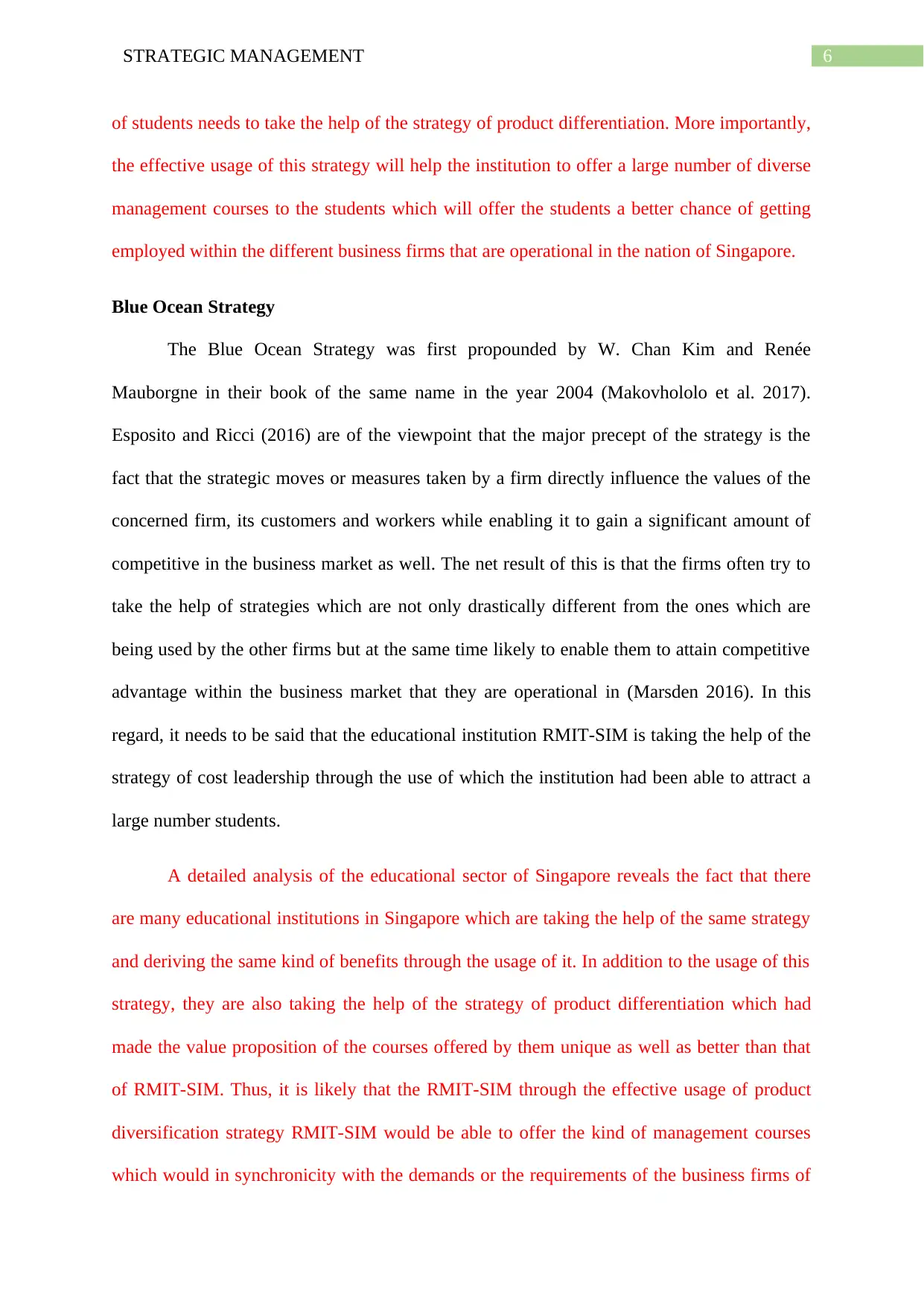
6STRATEGIC MANAGEMENT
of students needs to take the help of the strategy of product differentiation. More importantly,
the effective usage of this strategy will help the institution to offer a large number of diverse
management courses to the students which will offer the students a better chance of getting
employed within the different business firms that are operational in the nation of Singapore.
Blue Ocean Strategy
The Blue Ocean Strategy was first propounded by W. Chan Kim and Renée
Mauborgne in their book of the same name in the year 2004 (Makovhololo et al. 2017).
Esposito and Ricci (2016) are of the viewpoint that the major precept of the strategy is the
fact that the strategic moves or measures taken by a firm directly influence the values of the
concerned firm, its customers and workers while enabling it to gain a significant amount of
competitive in the business market as well. The net result of this is that the firms often try to
take the help of strategies which are not only drastically different from the ones which are
being used by the other firms but at the same time likely to enable them to attain competitive
advantage within the business market that they are operational in (Marsden 2016). In this
regard, it needs to be said that the educational institution RMIT-SIM is taking the help of the
strategy of cost leadership through the use of which the institution had been able to attract a
large number students.
A detailed analysis of the educational sector of Singapore reveals the fact that there
are many educational institutions in Singapore which are taking the help of the same strategy
and deriving the same kind of benefits through the usage of it. In addition to the usage of this
strategy, they are also taking the help of the strategy of product differentiation which had
made the value proposition of the courses offered by them unique as well as better than that
of RMIT-SIM. Thus, it is likely that the RMIT-SIM through the effective usage of product
diversification strategy RMIT-SIM would be able to offer the kind of management courses
which would in synchronicity with the demands or the requirements of the business firms of
of students needs to take the help of the strategy of product differentiation. More importantly,
the effective usage of this strategy will help the institution to offer a large number of diverse
management courses to the students which will offer the students a better chance of getting
employed within the different business firms that are operational in the nation of Singapore.
Blue Ocean Strategy
The Blue Ocean Strategy was first propounded by W. Chan Kim and Renée
Mauborgne in their book of the same name in the year 2004 (Makovhololo et al. 2017).
Esposito and Ricci (2016) are of the viewpoint that the major precept of the strategy is the
fact that the strategic moves or measures taken by a firm directly influence the values of the
concerned firm, its customers and workers while enabling it to gain a significant amount of
competitive in the business market as well. The net result of this is that the firms often try to
take the help of strategies which are not only drastically different from the ones which are
being used by the other firms but at the same time likely to enable them to attain competitive
advantage within the business market that they are operational in (Marsden 2016). In this
regard, it needs to be said that the educational institution RMIT-SIM is taking the help of the
strategy of cost leadership through the use of which the institution had been able to attract a
large number students.
A detailed analysis of the educational sector of Singapore reveals the fact that there
are many educational institutions in Singapore which are taking the help of the same strategy
and deriving the same kind of benefits through the usage of it. In addition to the usage of this
strategy, they are also taking the help of the strategy of product differentiation which had
made the value proposition of the courses offered by them unique as well as better than that
of RMIT-SIM. Thus, it is likely that the RMIT-SIM through the effective usage of product
diversification strategy RMIT-SIM would be able to offer the kind of management courses
which would in synchronicity with the demands or the requirements of the business firms of
Paraphrase This Document
Need a fresh take? Get an instant paraphrase of this document with our AI Paraphraser
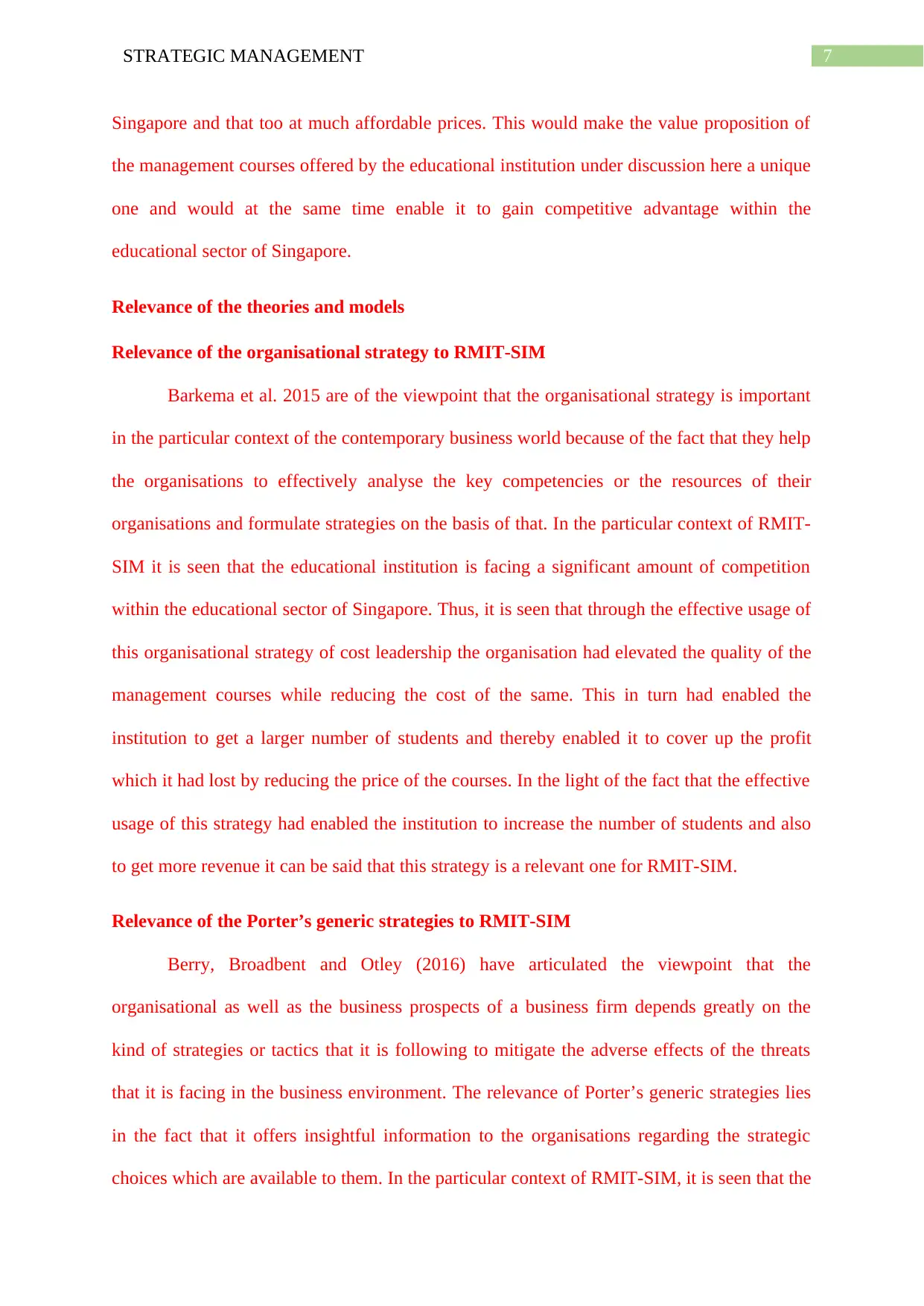
7STRATEGIC MANAGEMENT
Singapore and that too at much affordable prices. This would make the value proposition of
the management courses offered by the educational institution under discussion here a unique
one and would at the same time enable it to gain competitive advantage within the
educational sector of Singapore.
Relevance of the theories and models
Relevance of the organisational strategy to RMIT-SIM
Barkema et al. 2015 are of the viewpoint that the organisational strategy is important
in the particular context of the contemporary business world because of the fact that they help
the organisations to effectively analyse the key competencies or the resources of their
organisations and formulate strategies on the basis of that. In the particular context of RMIT-
SIM it is seen that the educational institution is facing a significant amount of competition
within the educational sector of Singapore. Thus, it is seen that through the effective usage of
this organisational strategy of cost leadership the organisation had elevated the quality of the
management courses while reducing the cost of the same. This in turn had enabled the
institution to get a larger number of students and thereby enabled it to cover up the profit
which it had lost by reducing the price of the courses. In the light of the fact that the effective
usage of this strategy had enabled the institution to increase the number of students and also
to get more revenue it can be said that this strategy is a relevant one for RMIT-SIM.
Relevance of the Porter’s generic strategies to RMIT-SIM
Berry, Broadbent and Otley (2016) have articulated the viewpoint that the
organisational as well as the business prospects of a business firm depends greatly on the
kind of strategies or tactics that it is following to mitigate the adverse effects of the threats
that it is facing in the business environment. The relevance of Porter’s generic strategies lies
in the fact that it offers insightful information to the organisations regarding the strategic
choices which are available to them. In the particular context of RMIT-SIM, it is seen that the
Singapore and that too at much affordable prices. This would make the value proposition of
the management courses offered by the educational institution under discussion here a unique
one and would at the same time enable it to gain competitive advantage within the
educational sector of Singapore.
Relevance of the theories and models
Relevance of the organisational strategy to RMIT-SIM
Barkema et al. 2015 are of the viewpoint that the organisational strategy is important
in the particular context of the contemporary business world because of the fact that they help
the organisations to effectively analyse the key competencies or the resources of their
organisations and formulate strategies on the basis of that. In the particular context of RMIT-
SIM it is seen that the educational institution is facing a significant amount of competition
within the educational sector of Singapore. Thus, it is seen that through the effective usage of
this organisational strategy of cost leadership the organisation had elevated the quality of the
management courses while reducing the cost of the same. This in turn had enabled the
institution to get a larger number of students and thereby enabled it to cover up the profit
which it had lost by reducing the price of the courses. In the light of the fact that the effective
usage of this strategy had enabled the institution to increase the number of students and also
to get more revenue it can be said that this strategy is a relevant one for RMIT-SIM.
Relevance of the Porter’s generic strategies to RMIT-SIM
Berry, Broadbent and Otley (2016) have articulated the viewpoint that the
organisational as well as the business prospects of a business firm depends greatly on the
kind of strategies or tactics that it is following to mitigate the adverse effects of the threats
that it is facing in the business environment. The relevance of Porter’s generic strategies lies
in the fact that it offers insightful information to the organisations regarding the strategic
choices which are available to them. In the particular context of RMIT-SIM, it is seen that the
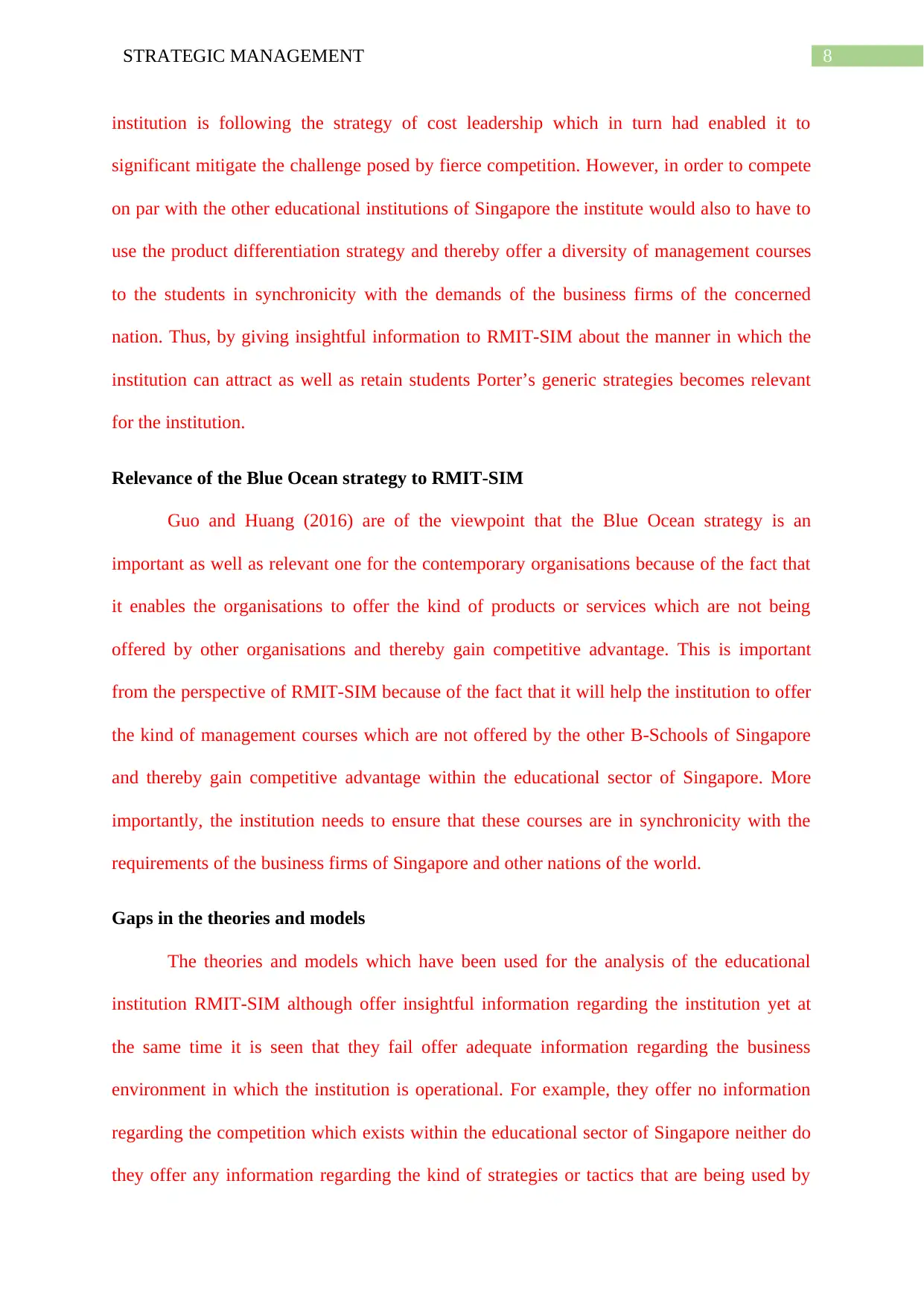
8STRATEGIC MANAGEMENT
institution is following the strategy of cost leadership which in turn had enabled it to
significant mitigate the challenge posed by fierce competition. However, in order to compete
on par with the other educational institutions of Singapore the institute would also to have to
use the product differentiation strategy and thereby offer a diversity of management courses
to the students in synchronicity with the demands of the business firms of the concerned
nation. Thus, by giving insightful information to RMIT-SIM about the manner in which the
institution can attract as well as retain students Porter’s generic strategies becomes relevant
for the institution.
Relevance of the Blue Ocean strategy to RMIT-SIM
Guo and Huang (2016) are of the viewpoint that the Blue Ocean strategy is an
important as well as relevant one for the contemporary organisations because of the fact that
it enables the organisations to offer the kind of products or services which are not being
offered by other organisations and thereby gain competitive advantage. This is important
from the perspective of RMIT-SIM because of the fact that it will help the institution to offer
the kind of management courses which are not offered by the other B-Schools of Singapore
and thereby gain competitive advantage within the educational sector of Singapore. More
importantly, the institution needs to ensure that these courses are in synchronicity with the
requirements of the business firms of Singapore and other nations of the world.
Gaps in the theories and models
The theories and models which have been used for the analysis of the educational
institution RMIT-SIM although offer insightful information regarding the institution yet at
the same time it is seen that they fail offer adequate information regarding the business
environment in which the institution is operational. For example, they offer no information
regarding the competition which exists within the educational sector of Singapore neither do
they offer any information regarding the kind of strategies or tactics that are being used by
institution is following the strategy of cost leadership which in turn had enabled it to
significant mitigate the challenge posed by fierce competition. However, in order to compete
on par with the other educational institutions of Singapore the institute would also to have to
use the product differentiation strategy and thereby offer a diversity of management courses
to the students in synchronicity with the demands of the business firms of the concerned
nation. Thus, by giving insightful information to RMIT-SIM about the manner in which the
institution can attract as well as retain students Porter’s generic strategies becomes relevant
for the institution.
Relevance of the Blue Ocean strategy to RMIT-SIM
Guo and Huang (2016) are of the viewpoint that the Blue Ocean strategy is an
important as well as relevant one for the contemporary organisations because of the fact that
it enables the organisations to offer the kind of products or services which are not being
offered by other organisations and thereby gain competitive advantage. This is important
from the perspective of RMIT-SIM because of the fact that it will help the institution to offer
the kind of management courses which are not offered by the other B-Schools of Singapore
and thereby gain competitive advantage within the educational sector of Singapore. More
importantly, the institution needs to ensure that these courses are in synchronicity with the
requirements of the business firms of Singapore and other nations of the world.
Gaps in the theories and models
The theories and models which have been used for the analysis of the educational
institution RMIT-SIM although offer insightful information regarding the institution yet at
the same time it is seen that they fail offer adequate information regarding the business
environment in which the institution is operational. For example, they offer no information
regarding the competition which exists within the educational sector of Singapore neither do
they offer any information regarding the kind of strategies or tactics that are being used by
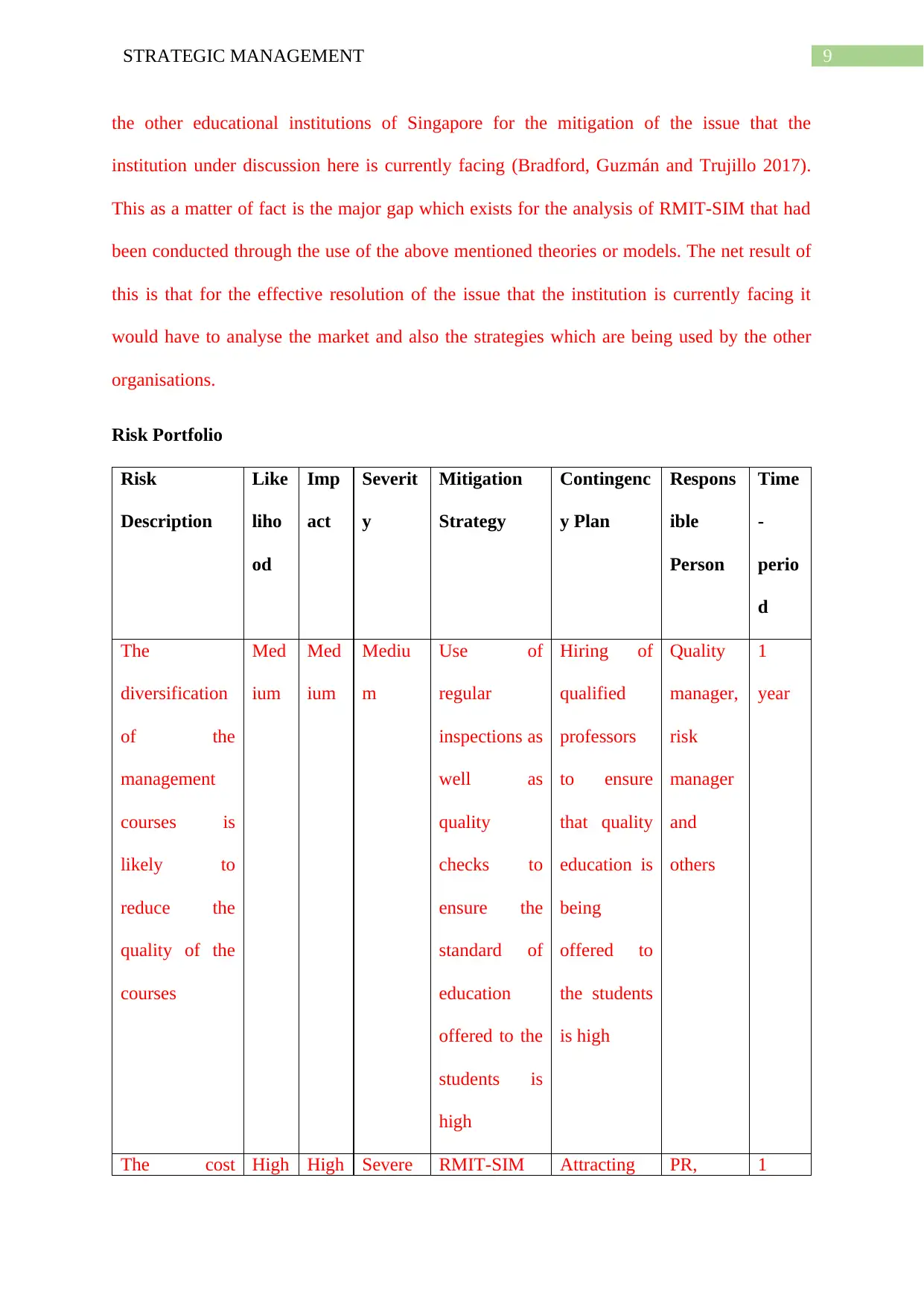
9STRATEGIC MANAGEMENT
the other educational institutions of Singapore for the mitigation of the issue that the
institution under discussion here is currently facing (Bradford, Guzmán and Trujillo 2017).
This as a matter of fact is the major gap which exists for the analysis of RMIT-SIM that had
been conducted through the use of the above mentioned theories or models. The net result of
this is that for the effective resolution of the issue that the institution is currently facing it
would have to analyse the market and also the strategies which are being used by the other
organisations.
Risk Portfolio
Risk
Description
Like
liho
od
Imp
act
Severit
y
Mitigation
Strategy
Contingenc
y Plan
Respons
ible
Person
Time
-
perio
d
The
diversification
of the
management
courses is
likely to
reduce the
quality of the
courses
Med
ium
Med
ium
Mediu
m
Use of
regular
inspections as
well as
quality
checks to
ensure the
standard of
education
offered to the
students is
high
Hiring of
qualified
professors
to ensure
that quality
education is
being
offered to
the students
is high
Quality
manager,
risk
manager
and
others
1
year
The cost High High Severe RMIT-SIM Attracting PR, 1
the other educational institutions of Singapore for the mitigation of the issue that the
institution under discussion here is currently facing (Bradford, Guzmán and Trujillo 2017).
This as a matter of fact is the major gap which exists for the analysis of RMIT-SIM that had
been conducted through the use of the above mentioned theories or models. The net result of
this is that for the effective resolution of the issue that the institution is currently facing it
would have to analyse the market and also the strategies which are being used by the other
organisations.
Risk Portfolio
Risk
Description
Like
liho
od
Imp
act
Severit
y
Mitigation
Strategy
Contingenc
y Plan
Respons
ible
Person
Time
-
perio
d
The
diversification
of the
management
courses is
likely to
reduce the
quality of the
courses
Med
ium
Med
ium
Mediu
m
Use of
regular
inspections as
well as
quality
checks to
ensure the
standard of
education
offered to the
students is
high
Hiring of
qualified
professors
to ensure
that quality
education is
being
offered to
the students
is high
Quality
manager,
risk
manager
and
others
1
year
The cost High High Severe RMIT-SIM Attracting PR, 1
Secure Best Marks with AI Grader
Need help grading? Try our AI Grader for instant feedback on your assignments.
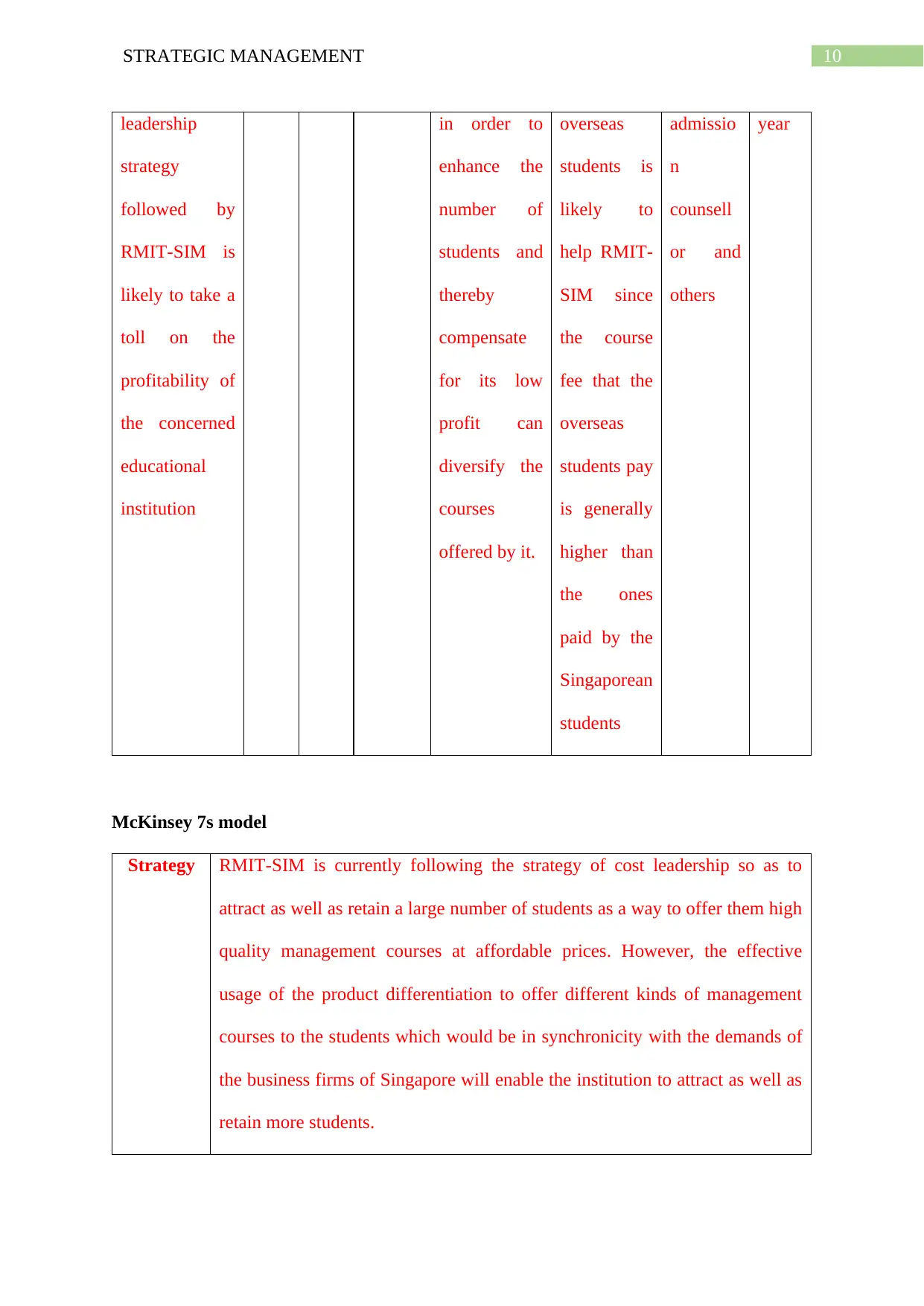
10STRATEGIC MANAGEMENT
leadership
strategy
followed by
RMIT-SIM is
likely to take a
toll on the
profitability of
the concerned
educational
institution
in order to
enhance the
number of
students and
thereby
compensate
for its low
profit can
diversify the
courses
offered by it.
overseas
students is
likely to
help RMIT-
SIM since
the course
fee that the
overseas
students pay
is generally
higher than
the ones
paid by the
Singaporean
students
admissio
n
counsell
or and
others
year
McKinsey 7s model
Strategy RMIT-SIM is currently following the strategy of cost leadership so as to
attract as well as retain a large number of students as a way to offer them high
quality management courses at affordable prices. However, the effective
usage of the product differentiation to offer different kinds of management
courses to the students which would be in synchronicity with the demands of
the business firms of Singapore will enable the institution to attract as well as
retain more students.
leadership
strategy
followed by
RMIT-SIM is
likely to take a
toll on the
profitability of
the concerned
educational
institution
in order to
enhance the
number of
students and
thereby
compensate
for its low
profit can
diversify the
courses
offered by it.
overseas
students is
likely to
help RMIT-
SIM since
the course
fee that the
overseas
students pay
is generally
higher than
the ones
paid by the
Singaporean
students
admissio
n
counsell
or and
others
year
McKinsey 7s model
Strategy RMIT-SIM is currently following the strategy of cost leadership so as to
attract as well as retain a large number of students as a way to offer them high
quality management courses at affordable prices. However, the effective
usage of the product differentiation to offer different kinds of management
courses to the students which would be in synchronicity with the demands of
the business firms of Singapore will enable the institution to attract as well as
retain more students.
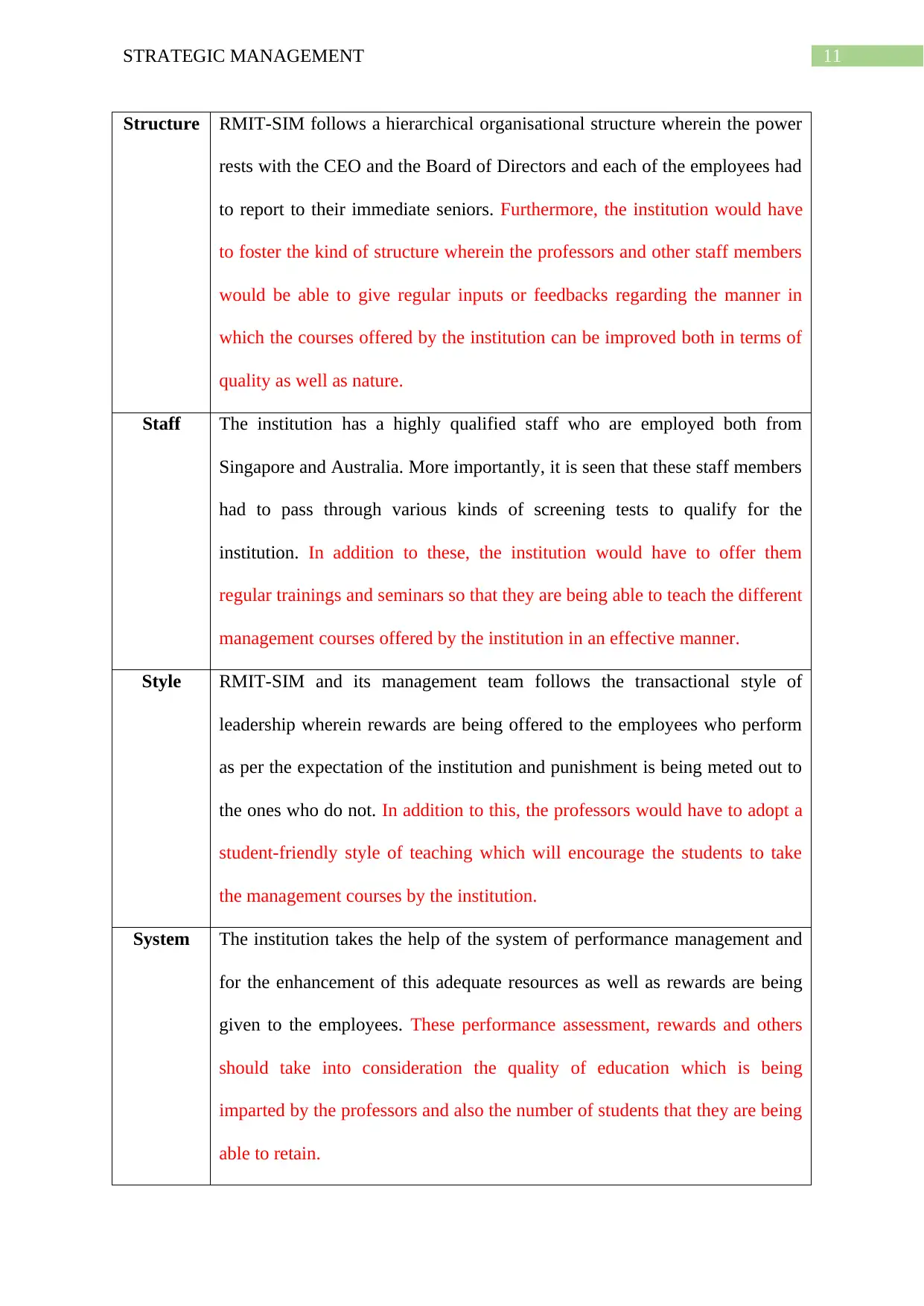
11STRATEGIC MANAGEMENT
Structure RMIT-SIM follows a hierarchical organisational structure wherein the power
rests with the CEO and the Board of Directors and each of the employees had
to report to their immediate seniors. Furthermore, the institution would have
to foster the kind of structure wherein the professors and other staff members
would be able to give regular inputs or feedbacks regarding the manner in
which the courses offered by the institution can be improved both in terms of
quality as well as nature.
Staff The institution has a highly qualified staff who are employed both from
Singapore and Australia. More importantly, it is seen that these staff members
had to pass through various kinds of screening tests to qualify for the
institution. In addition to these, the institution would have to offer them
regular trainings and seminars so that they are being able to teach the different
management courses offered by the institution in an effective manner.
Style RMIT-SIM and its management team follows the transactional style of
leadership wherein rewards are being offered to the employees who perform
as per the expectation of the institution and punishment is being meted out to
the ones who do not. In addition to this, the professors would have to adopt a
student-friendly style of teaching which will encourage the students to take
the management courses by the institution.
System The institution takes the help of the system of performance management and
for the enhancement of this adequate resources as well as rewards are being
given to the employees. These performance assessment, rewards and others
should take into consideration the quality of education which is being
imparted by the professors and also the number of students that they are being
able to retain.
Structure RMIT-SIM follows a hierarchical organisational structure wherein the power
rests with the CEO and the Board of Directors and each of the employees had
to report to their immediate seniors. Furthermore, the institution would have
to foster the kind of structure wherein the professors and other staff members
would be able to give regular inputs or feedbacks regarding the manner in
which the courses offered by the institution can be improved both in terms of
quality as well as nature.
Staff The institution has a highly qualified staff who are employed both from
Singapore and Australia. More importantly, it is seen that these staff members
had to pass through various kinds of screening tests to qualify for the
institution. In addition to these, the institution would have to offer them
regular trainings and seminars so that they are being able to teach the different
management courses offered by the institution in an effective manner.
Style RMIT-SIM and its management team follows the transactional style of
leadership wherein rewards are being offered to the employees who perform
as per the expectation of the institution and punishment is being meted out to
the ones who do not. In addition to this, the professors would have to adopt a
student-friendly style of teaching which will encourage the students to take
the management courses by the institution.
System The institution takes the help of the system of performance management and
for the enhancement of this adequate resources as well as rewards are being
given to the employees. These performance assessment, rewards and others
should take into consideration the quality of education which is being
imparted by the professors and also the number of students that they are being
able to retain.
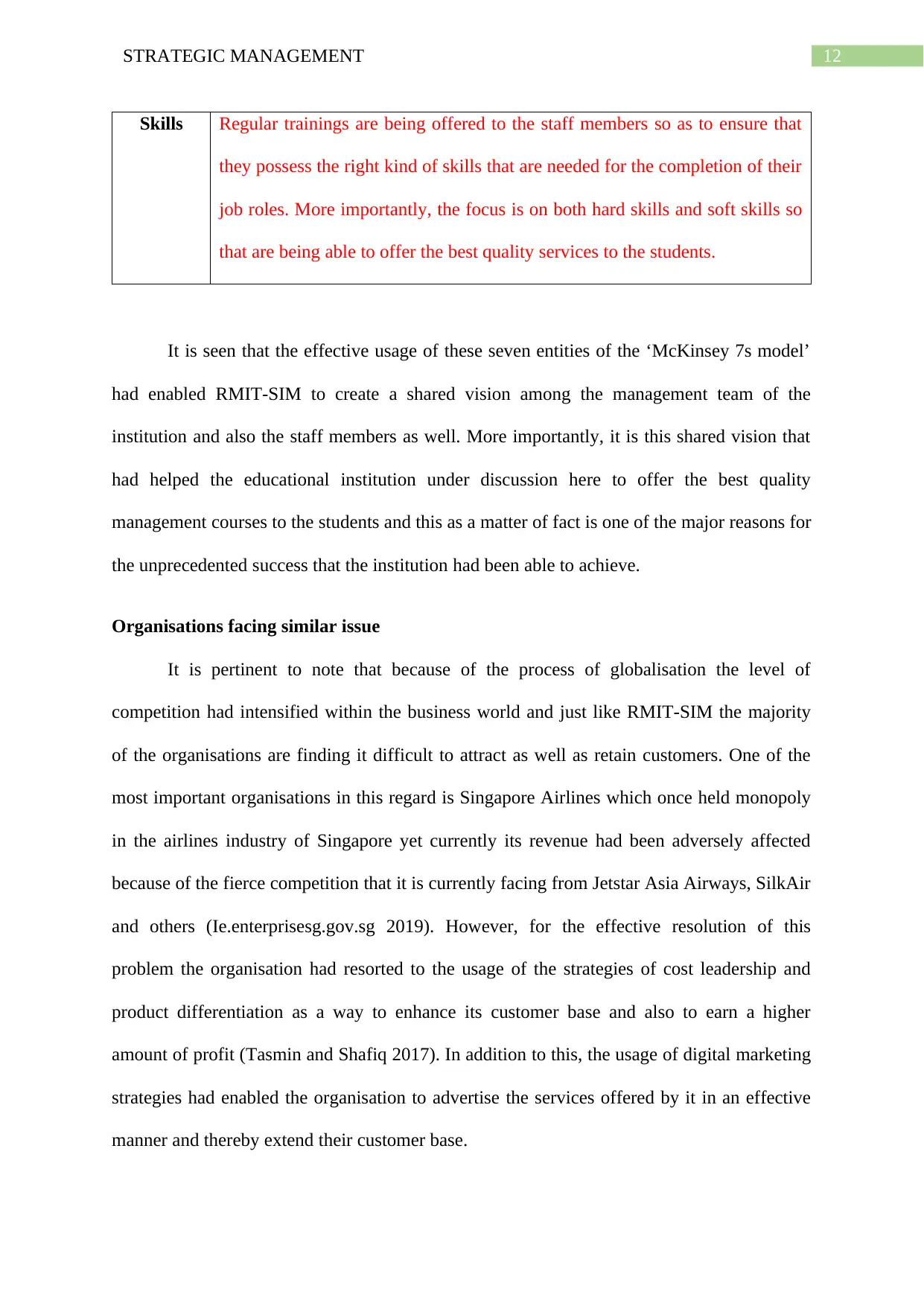
12STRATEGIC MANAGEMENT
Skills Regular trainings are being offered to the staff members so as to ensure that
they possess the right kind of skills that are needed for the completion of their
job roles. More importantly, the focus is on both hard skills and soft skills so
that are being able to offer the best quality services to the students.
It is seen that the effective usage of these seven entities of the ‘McKinsey 7s model’
had enabled RMIT-SIM to create a shared vision among the management team of the
institution and also the staff members as well. More importantly, it is this shared vision that
had helped the educational institution under discussion here to offer the best quality
management courses to the students and this as a matter of fact is one of the major reasons for
the unprecedented success that the institution had been able to achieve.
Organisations facing similar issue
It is pertinent to note that because of the process of globalisation the level of
competition had intensified within the business world and just like RMIT-SIM the majority
of the organisations are finding it difficult to attract as well as retain customers. One of the
most important organisations in this regard is Singapore Airlines which once held monopoly
in the airlines industry of Singapore yet currently its revenue had been adversely affected
because of the fierce competition that it is currently facing from Jetstar Asia Airways, SilkAir
and others (Ie.enterprisesg.gov.sg 2019). However, for the effective resolution of this
problem the organisation had resorted to the usage of the strategies of cost leadership and
product differentiation as a way to enhance its customer base and also to earn a higher
amount of profit (Tasmin and Shafiq 2017). In addition to this, the usage of digital marketing
strategies had enabled the organisation to advertise the services offered by it in an effective
manner and thereby extend their customer base.
Skills Regular trainings are being offered to the staff members so as to ensure that
they possess the right kind of skills that are needed for the completion of their
job roles. More importantly, the focus is on both hard skills and soft skills so
that are being able to offer the best quality services to the students.
It is seen that the effective usage of these seven entities of the ‘McKinsey 7s model’
had enabled RMIT-SIM to create a shared vision among the management team of the
institution and also the staff members as well. More importantly, it is this shared vision that
had helped the educational institution under discussion here to offer the best quality
management courses to the students and this as a matter of fact is one of the major reasons for
the unprecedented success that the institution had been able to achieve.
Organisations facing similar issue
It is pertinent to note that because of the process of globalisation the level of
competition had intensified within the business world and just like RMIT-SIM the majority
of the organisations are finding it difficult to attract as well as retain customers. One of the
most important organisations in this regard is Singapore Airlines which once held monopoly
in the airlines industry of Singapore yet currently its revenue had been adversely affected
because of the fierce competition that it is currently facing from Jetstar Asia Airways, SilkAir
and others (Ie.enterprisesg.gov.sg 2019). However, for the effective resolution of this
problem the organisation had resorted to the usage of the strategies of cost leadership and
product differentiation as a way to enhance its customer base and also to earn a higher
amount of profit (Tasmin and Shafiq 2017). In addition to this, the usage of digital marketing
strategies had enabled the organisation to advertise the services offered by it in an effective
manner and thereby extend their customer base.
Paraphrase This Document
Need a fresh take? Get an instant paraphrase of this document with our AI Paraphraser
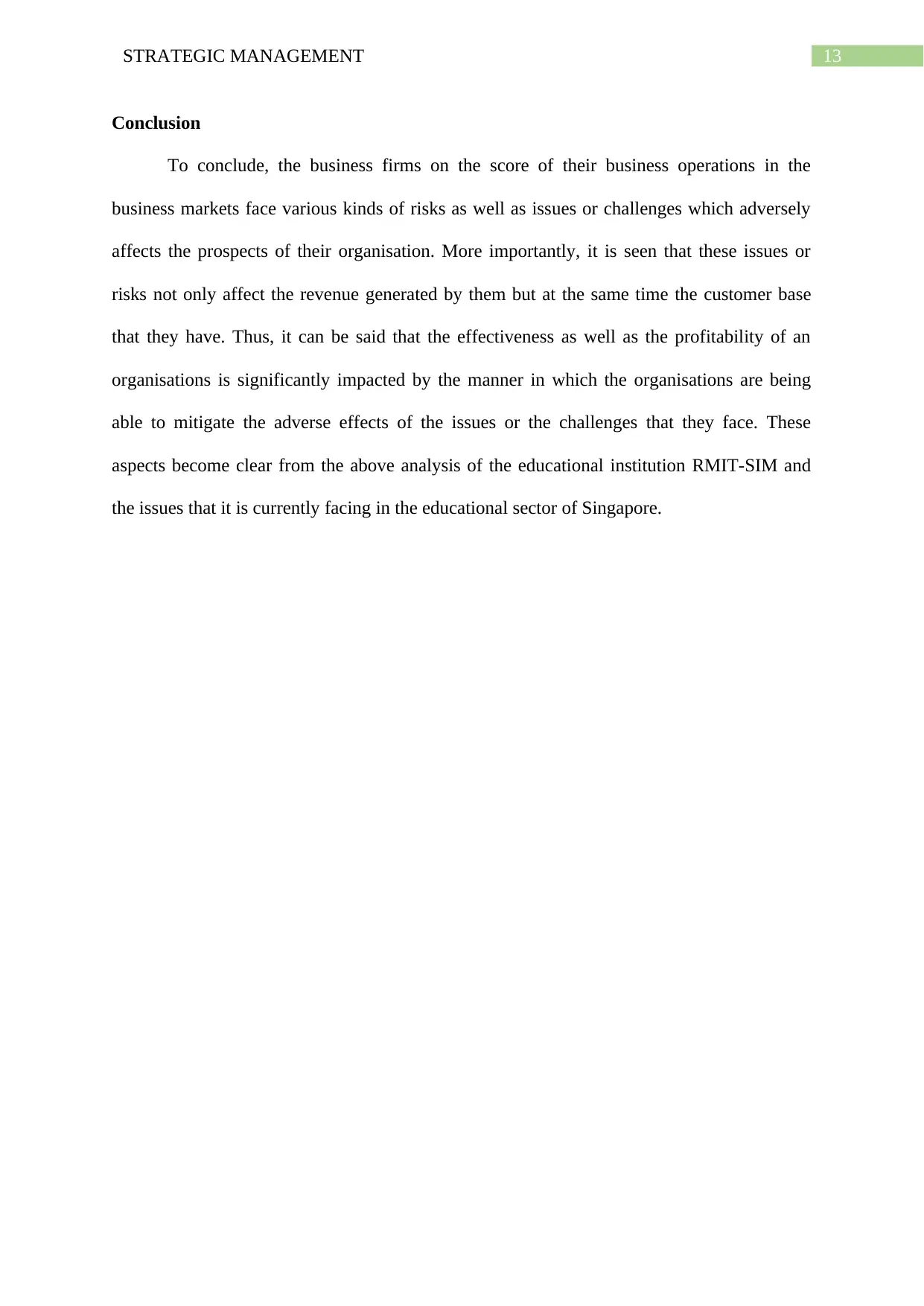
13STRATEGIC MANAGEMENT
Conclusion
To conclude, the business firms on the score of their business operations in the
business markets face various kinds of risks as well as issues or challenges which adversely
affects the prospects of their organisation. More importantly, it is seen that these issues or
risks not only affect the revenue generated by them but at the same time the customer base
that they have. Thus, it can be said that the effectiveness as well as the profitability of an
organisations is significantly impacted by the manner in which the organisations are being
able to mitigate the adverse effects of the issues or the challenges that they face. These
aspects become clear from the above analysis of the educational institution RMIT-SIM and
the issues that it is currently facing in the educational sector of Singapore.
Conclusion
To conclude, the business firms on the score of their business operations in the
business markets face various kinds of risks as well as issues or challenges which adversely
affects the prospects of their organisation. More importantly, it is seen that these issues or
risks not only affect the revenue generated by them but at the same time the customer base
that they have. Thus, it can be said that the effectiveness as well as the profitability of an
organisations is significantly impacted by the manner in which the organisations are being
able to mitigate the adverse effects of the issues or the challenges that they face. These
aspects become clear from the above analysis of the educational institution RMIT-SIM and
the issues that it is currently facing in the educational sector of Singapore.
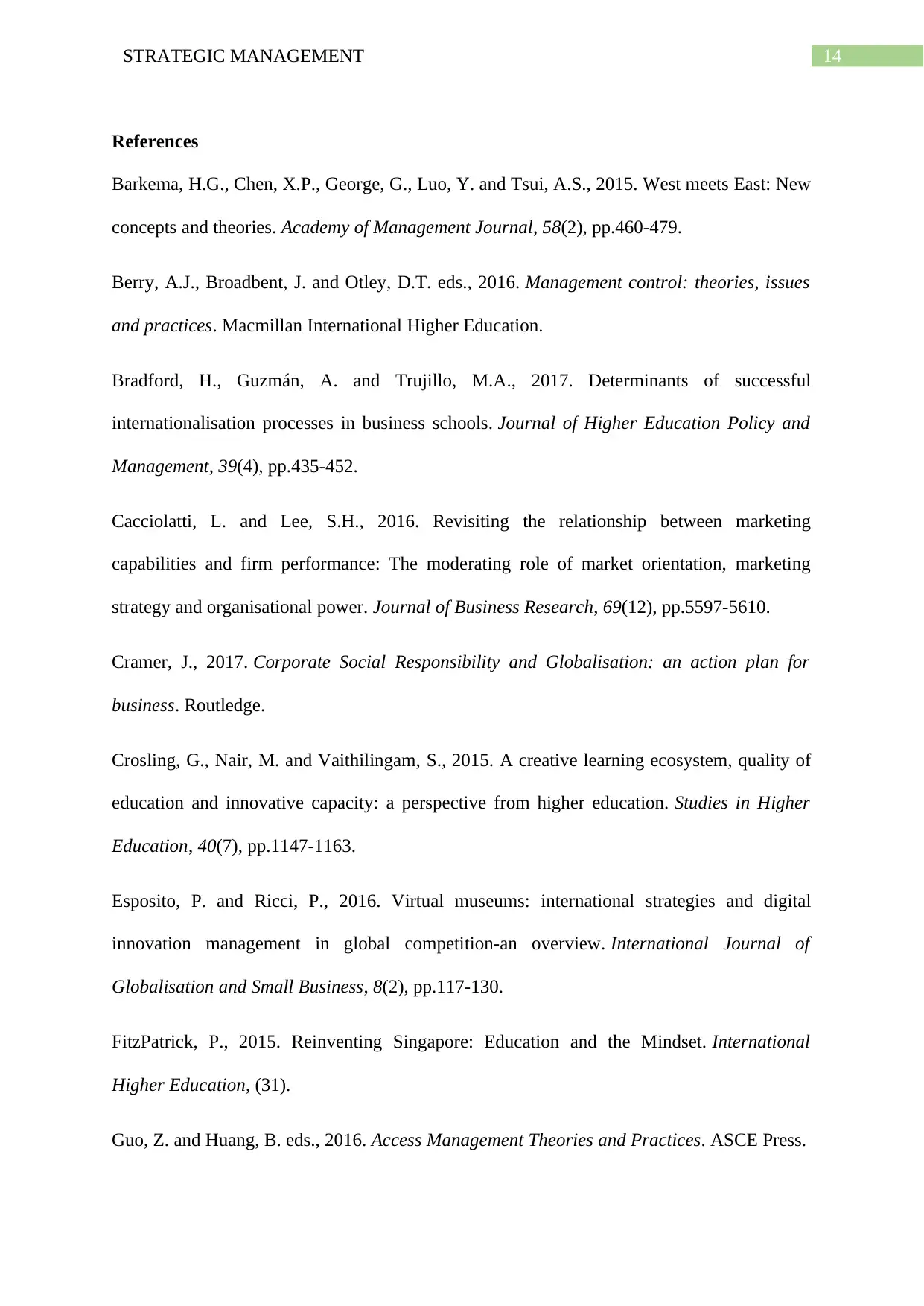
14STRATEGIC MANAGEMENT
References
Barkema, H.G., Chen, X.P., George, G., Luo, Y. and Tsui, A.S., 2015. West meets East: New
concepts and theories. Academy of Management Journal, 58(2), pp.460-479.
Berry, A.J., Broadbent, J. and Otley, D.T. eds., 2016. Management control: theories, issues
and practices. Macmillan International Higher Education.
Bradford, H., Guzmán, A. and Trujillo, M.A., 2017. Determinants of successful
internationalisation processes in business schools. Journal of Higher Education Policy and
Management, 39(4), pp.435-452.
Cacciolatti, L. and Lee, S.H., 2016. Revisiting the relationship between marketing
capabilities and firm performance: The moderating role of market orientation, marketing
strategy and organisational power. Journal of Business Research, 69(12), pp.5597-5610.
Cramer, J., 2017. Corporate Social Responsibility and Globalisation: an action plan for
business. Routledge.
Crosling, G., Nair, M. and Vaithilingam, S., 2015. A creative learning ecosystem, quality of
education and innovative capacity: a perspective from higher education. Studies in Higher
Education, 40(7), pp.1147-1163.
Esposito, P. and Ricci, P., 2016. Virtual museums: international strategies and digital
innovation management in global competition-an overview. International Journal of
Globalisation and Small Business, 8(2), pp.117-130.
FitzPatrick, P., 2015. Reinventing Singapore: Education and the Mindset. International
Higher Education, (31).
Guo, Z. and Huang, B. eds., 2016. Access Management Theories and Practices. ASCE Press.
References
Barkema, H.G., Chen, X.P., George, G., Luo, Y. and Tsui, A.S., 2015. West meets East: New
concepts and theories. Academy of Management Journal, 58(2), pp.460-479.
Berry, A.J., Broadbent, J. and Otley, D.T. eds., 2016. Management control: theories, issues
and practices. Macmillan International Higher Education.
Bradford, H., Guzmán, A. and Trujillo, M.A., 2017. Determinants of successful
internationalisation processes in business schools. Journal of Higher Education Policy and
Management, 39(4), pp.435-452.
Cacciolatti, L. and Lee, S.H., 2016. Revisiting the relationship between marketing
capabilities and firm performance: The moderating role of market orientation, marketing
strategy and organisational power. Journal of Business Research, 69(12), pp.5597-5610.
Cramer, J., 2017. Corporate Social Responsibility and Globalisation: an action plan for
business. Routledge.
Crosling, G., Nair, M. and Vaithilingam, S., 2015. A creative learning ecosystem, quality of
education and innovative capacity: a perspective from higher education. Studies in Higher
Education, 40(7), pp.1147-1163.
Esposito, P. and Ricci, P., 2016. Virtual museums: international strategies and digital
innovation management in global competition-an overview. International Journal of
Globalisation and Small Business, 8(2), pp.117-130.
FitzPatrick, P., 2015. Reinventing Singapore: Education and the Mindset. International
Higher Education, (31).
Guo, Z. and Huang, B. eds., 2016. Access Management Theories and Practices. ASCE Press.
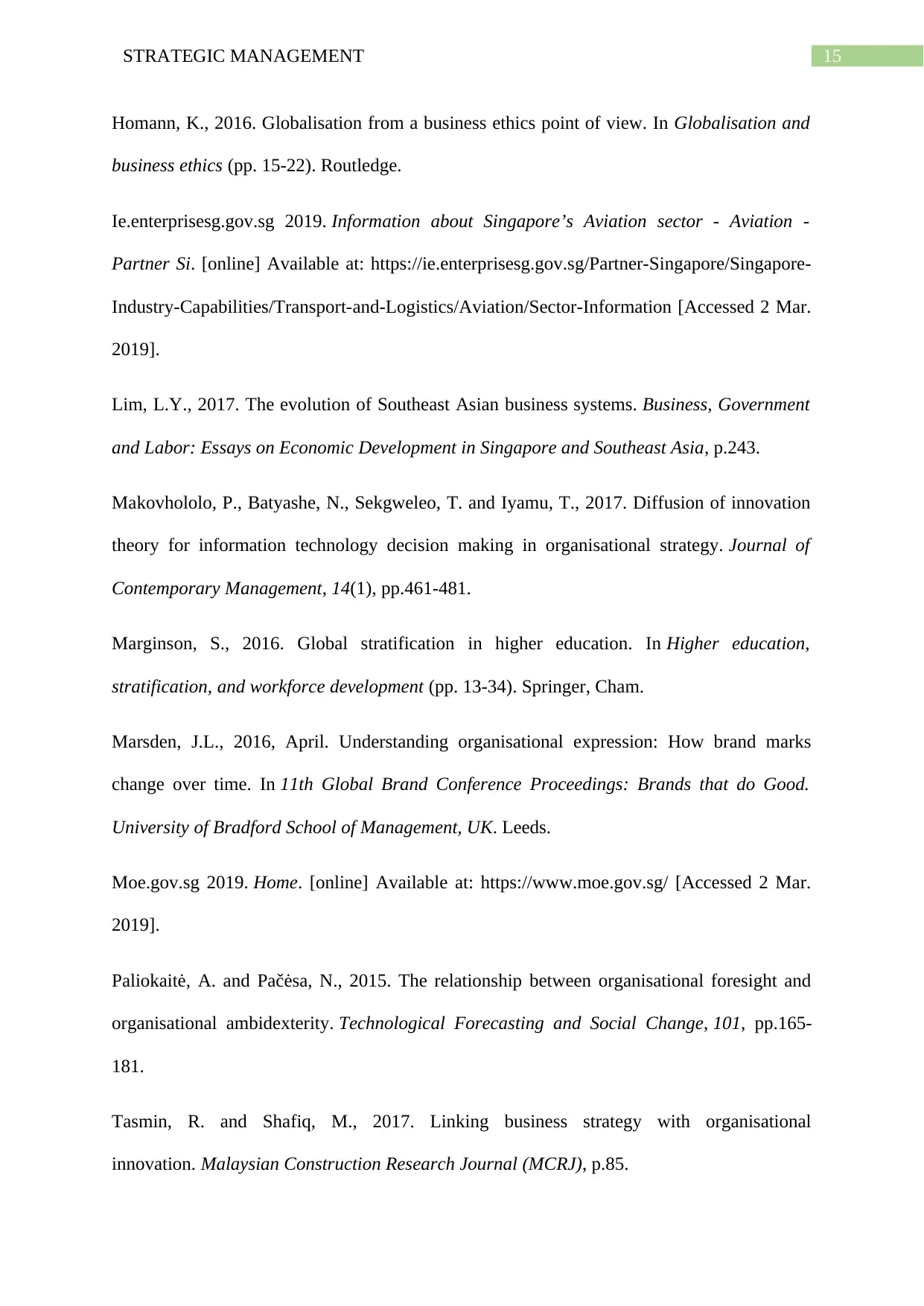
15STRATEGIC MANAGEMENT
Homann, K., 2016. Globalisation from a business ethics point of view. In Globalisation and
business ethics (pp. 15-22). Routledge.
Ie.enterprisesg.gov.sg 2019. Information about Singapore’s Aviation sector - Aviation -
Partner Si. [online] Available at: https://ie.enterprisesg.gov.sg/Partner-Singapore/Singapore-
Industry-Capabilities/Transport-and-Logistics/Aviation/Sector-Information [Accessed 2 Mar.
2019].
Lim, L.Y., 2017. The evolution of Southeast Asian business systems. Business, Government
and Labor: Essays on Economic Development in Singapore and Southeast Asia, p.243.
Makovhololo, P., Batyashe, N., Sekgweleo, T. and Iyamu, T., 2017. Diffusion of innovation
theory for information technology decision making in organisational strategy. Journal of
Contemporary Management, 14(1), pp.461-481.
Marginson, S., 2016. Global stratification in higher education. In Higher education,
stratification, and workforce development (pp. 13-34). Springer, Cham.
Marsden, J.L., 2016, April. Understanding organisational expression: How brand marks
change over time. In 11th Global Brand Conference Proceedings: Brands that do Good.
University of Bradford School of Management, UK. Leeds.
Moe.gov.sg 2019. Home. [online] Available at: https://www.moe.gov.sg/ [Accessed 2 Mar.
2019].
Paliokaitė, A. and Pačėsa, N., 2015. The relationship between organisational foresight and
organisational ambidexterity. Technological Forecasting and Social Change, 101, pp.165-
181.
Tasmin, R. and Shafiq, M., 2017. Linking business strategy with organisational
innovation. Malaysian Construction Research Journal (MCRJ), p.85.
Homann, K., 2016. Globalisation from a business ethics point of view. In Globalisation and
business ethics (pp. 15-22). Routledge.
Ie.enterprisesg.gov.sg 2019. Information about Singapore’s Aviation sector - Aviation -
Partner Si. [online] Available at: https://ie.enterprisesg.gov.sg/Partner-Singapore/Singapore-
Industry-Capabilities/Transport-and-Logistics/Aviation/Sector-Information [Accessed 2 Mar.
2019].
Lim, L.Y., 2017. The evolution of Southeast Asian business systems. Business, Government
and Labor: Essays on Economic Development in Singapore and Southeast Asia, p.243.
Makovhololo, P., Batyashe, N., Sekgweleo, T. and Iyamu, T., 2017. Diffusion of innovation
theory for information technology decision making in organisational strategy. Journal of
Contemporary Management, 14(1), pp.461-481.
Marginson, S., 2016. Global stratification in higher education. In Higher education,
stratification, and workforce development (pp. 13-34). Springer, Cham.
Marsden, J.L., 2016, April. Understanding organisational expression: How brand marks
change over time. In 11th Global Brand Conference Proceedings: Brands that do Good.
University of Bradford School of Management, UK. Leeds.
Moe.gov.sg 2019. Home. [online] Available at: https://www.moe.gov.sg/ [Accessed 2 Mar.
2019].
Paliokaitė, A. and Pačėsa, N., 2015. The relationship between organisational foresight and
organisational ambidexterity. Technological Forecasting and Social Change, 101, pp.165-
181.
Tasmin, R. and Shafiq, M., 2017. Linking business strategy with organisational
innovation. Malaysian Construction Research Journal (MCRJ), p.85.
Secure Best Marks with AI Grader
Need help grading? Try our AI Grader for instant feedback on your assignments.

16STRATEGIC MANAGEMENT
1 out of 17
Related Documents
Your All-in-One AI-Powered Toolkit for Academic Success.
+13062052269
info@desklib.com
Available 24*7 on WhatsApp / Email
![[object Object]](/_next/static/media/star-bottom.7253800d.svg)
Unlock your academic potential
© 2024 | Zucol Services PVT LTD | All rights reserved.



